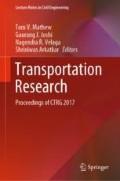Abstract
This study determines critical gaps using different methods like Raff’s, maximum likelihood (MLM), root-mean-square (RMS), probability equilibrium (PEM), and logit. These are then compared to single out the most appropriate one. Five locations in the western part of India are studied, selected based on type of land use, number of lanes, and carriage-way width. Video cameras were used to capture the mixed-traffic flow and pedestrian crossing movements simultaneously. The results also conclude that logit method is the most appropriate one for estimating critical gap, as it considers the effect of pedestrian behaviour and vehicular characteristics concurrently. The critical gap values vary considerably when pedestrian characteristics are considered. The results are expected to provide inputs for framing design parameters for pedestrian crossing facilities, thereby enhancing pedestrian safety.
Access this chapter
Tax calculation will be finalised at checkout
Purchases are for personal use only
References
Mohan D, Tsimhoni O, Sivak M, Flannagan MJ (2009) Road Safety in India: Challenges and Opportunities. University of Michigan, USA
Highway Capacity Manual (2010) Transportation Research Board, Washington, DC
DiPietro M, King L (1970) Pedestrian gap-acceptance. Highway Res Rec 308:80–91
Oxley J, Fildes B, Ihsen E, Charlton J, Days R (2005) Crossing roads safely: an experimental study of age differences in gap selection by pedestrians. Accid Anal Prev 37:962–971
Brilon W, Koenig R, Troutbeck RJ (1999) Useful estimation procedures for critical gaps. Transp Res Part A 33:161–186
Raff MS, Hart JW (1950) A volume warrant for urban stop signs, eno foundation for highway traffic control. Saugatuck, Connecticut
Ashworth R (1970) The analysis and interpretation of gap acceptance data. Transport Sci 4(3):270–280
Tian Z, Vandehey M, Robinson BW, Kittelson W, Kyte M, Troutbeck R, Brilon W, Wu N (1999) Implementing the maximum likelihood methodology to measure a driver’s critical gap. Transport Res Part A Pol Pract 33(3):187–197
Hamed MM (2001) Analysis of pedestrians’ behavior at pedestrian crossings. Saf Sci 38(1):63–82
Rastogi R, Chandra S, Vamsheedhar J, Das VR (2011) Parametric study of pedestrian speeds at midblock crossings. J Urban Plann Dev. http://dx.doi.org/10.1061/(ASCE)UP.19435444.0000083. 137(4):381–389
Kadali BR, Vedagiri P (2015) Modelling pedestrian road crossing behavior under mixed traffic condition. Eur Trans 55(3):1–17
Chandra S, Rastogi R, Das VR (2014) Descriptive and parametric analysis of pedestrian gap acceptance in mixed traffic conditions. KSCE J Civil Eng 18(1):284–293
Tanaboriboon Y, Guyano JA (1991) Analysis of pedestrian movements in Bangkok. Transportation 40 research record 1294, TRB, Washington, D.C., pp 52–56
Laxman KK, Rastogi R, Chandra S (2010) Pedestrian flow characteristics in mixed traffic conditions. J Urban Plann Dev ASCE 136:23–33
Chandra S, Bharti AK (2013) Speed distribution curves for pedestrians during walking and crossing. In: Conference of Transportation Research Group of India (2nd CTRG) procedia––social and behavioral sciences 104:660–667
Pawar S, Patil (2014) Pedestrian temporal and spatial gap acceptance at Mid-block Street crossing in developing world. In: 95th annual transportation research board meeting, Washington D.C
Wu N (2006) A new model for estimating critical gap and its distribution at un-signalized intersections based on the equilibrium of probabilities. In: Proceeding of the 5th international symposium on highway capacity and quality of service. Yokohama, Japan, 25–29 July, Transportation Research Board of the National Academies, Washington, D.C
Kadali BR, Vedagiri P (2016) Analysis of critical gap based on pedestrian behaviour during peak traffic hours at unprotected midblock crosswalks. Asian Trans Stud 4(1):261–277
Chandra S, Kumar U (2003) Effect of lane width on capacity under mixed traffic conditions in India. J Transport Eng ASCE 129:155–160
Fitpatrick K (1991) Gaps accepted at stop-controlled intersections. Transport Res Rec J Transport Res Board 1303:103–112
Troutbeck RJ (1992) Estimating the critical acceptance gap from traffic movements, Queensland University of Technology
Wu N (2012) Equilibrium of probabilities for estimating distribution function of critical gaps at un-signalized intersections. Transport Res Rec J Transport Res Board 2286:49–55
Cassidy MJ, Madanat SM, Wang M-H, Yang F (1995) Un-signalized intersection capacity and level of service: revisiting critical gap. Preprint 950138, Transportation Research Board, Annual meeting
IRC: 103 (2012) Guidelines for pedestrian facilities, Indian road congress (IRC) New Delhi, India
Kumar P, Parida M (2011) Vulnerable road users in multimodal transport system for Delhi. Journeys, LTA 6:38–47
Troutbeck RJ (2014) Estimating the mean critical gap. In: 93rd annual meeting of Transportation Research Board, CD-ROM
Chaudhari A, Shah J, Arkatkar S, Joshi G, Parida M (2016) Examining effect of individual characteristics on walking speed at un-signalized mid-block crossings. In: 95rd annual meeting of Transportation Research Board, CD-ROM (2016)
Acknowledgements
This study is part of a project sponsored by planning commission of India entitled ‘Development of Indo-HCM’. The authors are grateful to Central Road Research Institute Delhi for their support and funding provided by them.
Author information
Authors and Affiliations
Corresponding author
Editor information
Editors and Affiliations
Rights and permissions
Copyright information
© 2020 Springer Nature Singapore Pte Ltd.
About this paper
Cite this paper
Vinayaraj, V.S., Chaudhari, A., Arkatkar, S., Joshi, G.J., Parida, M. (2020). Comparative Study of Pedestrian Critical Gap Estimation Methods at Unsignalized Midblock Crosswalks. In: Mathew, T., Joshi, G., Velaga, N., Arkatkar, S. (eds) Transportation Research . Lecture Notes in Civil Engineering, vol 45. Springer, Singapore. https://doi.org/10.1007/978-981-32-9042-6_13
Download citation
DOI: https://doi.org/10.1007/978-981-32-9042-6_13
Published:
Publisher Name: Springer, Singapore
Print ISBN: 978-981-32-9041-9
Online ISBN: 978-981-32-9042-6
eBook Packages: EngineeringEngineering (R0)

